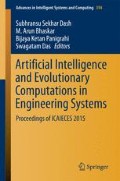Abstract
Low-density parity check (LDPC) codes are the capacity approaching codes having better decoding performance closer to Shannon’s limit. The performance of the LDPC codes depends on the block length, code rate, structure of parity check matrix (H-matrix), and on the decoding process. Various code construction methods are structured including Quasi-cyclic-irregular parity check matrix to improve the performance of the LDPC codes. Cellular Automata are a computational method that realizes the complex computational blocks into simple, regular, and modular structures. In this paper, the cellular automata-based LDPC parity check matrix with hierarchical diagonal parity check matrix structure has been incorporated in the decoder design. Error performance improvement of 0.0417 dB is obtained with HDPCM-based LDPC decoder using cellular automata. Performance analysis on increased code length validates the proposed LDPC decoder with the improved decoding performance.
Access this chapter
Tax calculation will be finalised at checkout
Purchases are for personal use only
References
Gallager RG. Low density parity check codes. IRE Trans Inf Theory 1962;IT-8:21–28.
Davey MC, Mackay DJC. Low density parity check codes GF (q). IEEE Commun Lett. 1998;2(6):165–7.
Ma X. On constructing low density parity–check codes. PhD thesis, University of Waterloo, Ontario, Canada; 2007.
Barnault L, Declercq D. Fast decoding algorithm for LDPC over GF(2q). Inf Theory Workshop 2003;2003:70–73.
Zhou B, Kang J, Song S, Lin S, Abdel-Ghaffar K, Xu M. Construction of non-binary quasi-cyclic LDPC codes by arrays and array dispersions. IEEE Trans Commun 2009;57(6):1652, 1662.
Song H, Cruz JR. Reduced-complexity decoding of Q-ary LDPC codes for magnetic recording. IEEE Trans Magn. 2003;39(2):1081–1087.
Hong H, Sun Z. An improved decoding algorithm of non binary LDPC code. In: 2011 International Conference on Information Technology, Computer Engineering and Management Sciences (ICM), vol 3; 2011. p. 104,107, 24–25.
Koroglu ME, Şiap I, Akın H. Cellular automata based byte error correcting codes over finite fields. In: American Institute of Physics Conference Proceedings, 2012, p. 183.
Cho S-J, Choi U-S, Heo S-H. Design of double error correcting codes based on cellular automata. J Appl Math Comput. 2006;21(1–2):545–53.
Sasidhar K, Chattopadhyay S, Chaudhuri PP. CAA decoder for cellular automata based byte error correcting code. IEEE Trans Comput. 1996;45(9):1003–16.
Das Debasis, Ray Abhishek. A parallel encryption algorithm for block ciphers based on reversible programmable cellular automata. J Comput Sci Eng. 2010;1(1):82–90.
Corsonello P, Spezzano G, Staino G, Talia D. Efficient implementation of cellular algorithms on reconfigurable hardware. In: Proceedings 10th Euromicro Workshop on Parallel, Distributed and Network-based Processing, 2002, p. 211, 218.
Wolfram. Theory and applications of cellular automata. In: Advanced series on complex systems, vol 1. Singapore: World Scientific, 1986. p. 485–557.
Tomassini M, Sipper M, Zolla M, Perrenoud M. Generating high-quality random numbers in parallel by cellular automata. Future Gener Comput Syst. 1999;16:291–305.
Carrasco RA, Johnston M. Non-binary error control coding for wireless communication and data storage. London: Wiley; 2008.
Tanner RM. A recursive approach to low complexity codes. IEEE Trans Inf Theory 1981;533–547.
Author information
Authors and Affiliations
Corresponding author
Editor information
Editors and Affiliations
Rights and permissions
Copyright information
© 2016 Springer India
About this paper
Cite this paper
Abisha Queen, C., Anbuselvi, M., Salivahanan, S. (2016). Cellular Automata-Based LDPC Decoder. In: Dash, S., Bhaskar, M., Panigrahi, B., Das, S. (eds) Artificial Intelligence and Evolutionary Computations in Engineering Systems. Advances in Intelligent Systems and Computing, vol 394. Springer, New Delhi. https://doi.org/10.1007/978-81-322-2656-7_80
Download citation
DOI: https://doi.org/10.1007/978-81-322-2656-7_80
Published:
Publisher Name: Springer, New Delhi
Print ISBN: 978-81-322-2654-3
Online ISBN: 978-81-322-2656-7
eBook Packages: EngineeringEngineering (R0)

